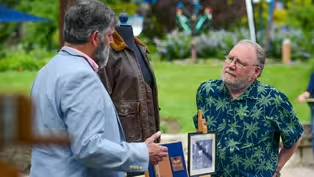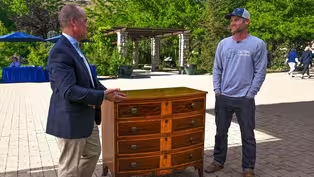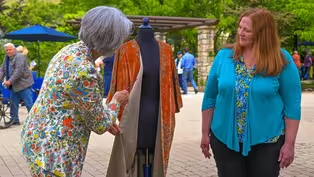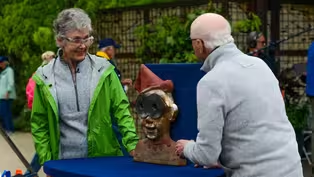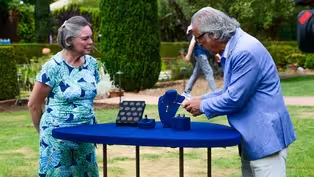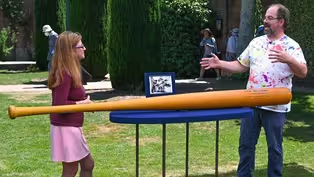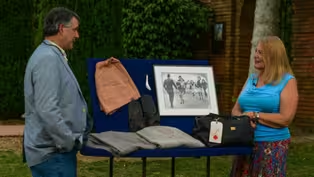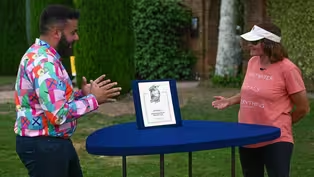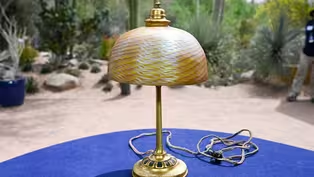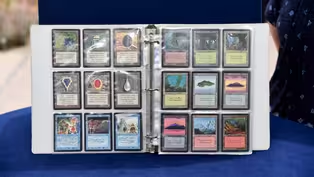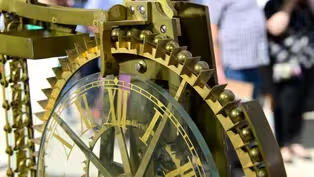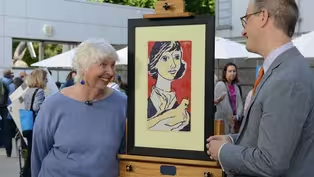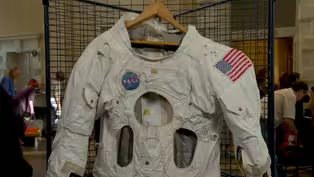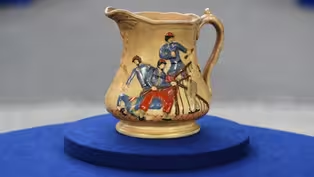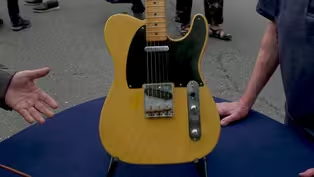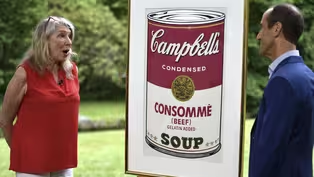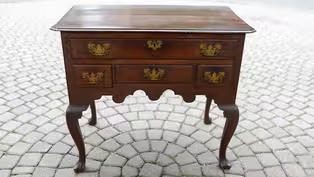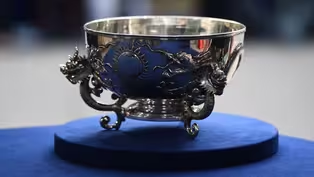
RECUT: Winterthur Museum, Garden & Library, Part 2
Special | 22m 27sVideo has Closed Captions
Discover Delaware treasures in this half-hour RECUT, including one valued at $50,000!
Discover Delaware treasures in this half-hour RECUT, such as a NASA Apollo space suit, ca. 1969, a Samuel Yellin light fixture, ca. 1910, and a 1968 Warhol Campbell's Soup can screenprint. Which is valued at $50,000?
Problems playing video? | Closed Captioning Feedback
Problems playing video? | Closed Captioning Feedback
Funding for ANTIQUES ROADSHOW is provided by Ancestry and American Cruise Lines. Additional funding is provided by public television viewers.

RECUT: Winterthur Museum, Garden & Library, Part 2
Special | 22m 27sVideo has Closed Captions
Discover Delaware treasures in this half-hour RECUT, such as a NASA Apollo space suit, ca. 1969, a Samuel Yellin light fixture, ca. 1910, and a 1968 Warhol Campbell's Soup can screenprint. Which is valued at $50,000?
Problems playing video? | Closed Captioning Feedback
How to Watch Antiques Roadshow
Antiques Roadshow is available to stream on pbs.org and the free PBS App, available on iPhone, Apple TV, Android TV, Android smartphones, Amazon Fire TV, Amazon Fire Tablet, Roku, Samsung Smart TV, and Vizio.
Buy Now
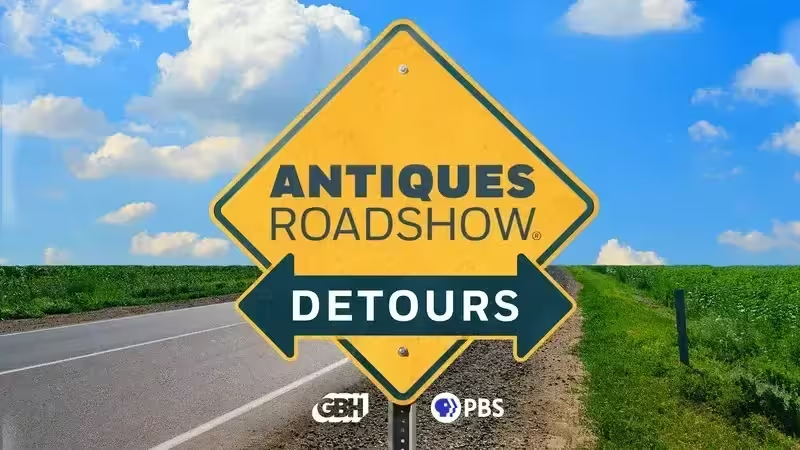
ANTIQUES ROADSHOW DETOURS
Ever wondered what happens to the treasures featured on America’s beloved ANTIQUES ROADSHOW after the cameras leave town? Host Adam Monahan tracks down the juicy afterlives of your favorite finds from PBS’s hit series.Providing Support for PBS.org
Learn Moreabout PBS online sponsorshipMore from This Collection
America’s favorite treasure hunt ANTIQUES ROADSHOW presents a bite-sized way to enjoy the show. ANTIQUES ROADSHOW RECUT features thirty-minute episodes, packed full of favorite finds and paced for maximum entertainment. RECUT features episodes recut from the show’s previous visits to distinctive and historic locations across the country.
RECUT: Idaho Botanical Garden, Part 4
Video has Closed Captions
Wrap up Season 4 of RECUT with a $50,000 appraisal at Idaho Botanical Garden! (22m 31s)
RECUT: Idaho Botanical Garden, Part 3
Video has Closed Captions
Visit the “City of Trees” for unbe-leaf-able Boise treasures in this half-hour RECUT. (22m 31s)
RECUT: Idaho Botanical Garden, Part 2
Video has Closed Captions
In this half-hour RECUT, watch breathtaking Boise appraisals at Idaho Botanical Garden. (22m 31s)
RECUT: Idaho Botanical Garden, Part 1
Video has Closed Captions
Gem State treasures sparkle in this half-hour RECUT at Idaho Botanical Garden! (22m 31s)
Video has Closed Captions
Watch wow-worthy Woodside finds in this half-hour RECUT and learn which is up to $44,000! (22m 24s)
Video has Closed Captions
In this half-hour RECUT episode, golden state treasures shine at Filoli. One is $150,000! (22m 23s)
Video has Closed Captions
Watch fascinating Filoli finds in this half-hour RECUT, including one up to $100,000! (22m 36s)
Video has Closed Captions
This season's first half-hour of RECUT wows our guests with a $200,000 to $330,000 find! (22m 30s)
RECUT: Desert Botanical Garden, Part 2
Video has Closed Captions
Phoenix treasures heat up, like one appraisal up to $35,000, in this half-hour RECUT! (22m 28s)
RECUT: Desert Botanical Garden, Part 1
Video has Closed Captions
Phenomenal Phoenix finds abound in this half-hour RECUT. One is worth up to $100,000! (22m 26s)
RECUT: Crocker Art Museum, Part 2
Video has Closed Captions
See stunning Sacramento finds like one $80,000-$125,000 treasure, in this half-hour RECUT! (22m 28s)
RECUT: Crocker Art Museum, Part 1
Video has Closed Captions
Head to California’s Crocker Art Museum for a bite-sized RECUT! One find is up to $75,000! (22m 27s)
Providing Support for PBS.org
Learn Moreabout PBS online sponsorship♪ ♪ CORAL PEÑA: "Antiques Roadshow Recut" returns to the Winterthur Museum, Garden, and Library in Winterthur, Delaware.
MAN: Lo and behold, this was there for 100 bucks and we got it.
What?
♪ ♪ PEÑA: In this half-hour, "Antiques Roadshow Recut" continues our visit to the Winterthur Museum, Garden, and Library.
The institution's mastermind, Henry Francis du Pont, turned his former home into a museum in 1951, and eventually the entire property, almost 1,000 acres, was opened to the public.
Winterthur provides a spectacular backdrop for our guests and their treasures-- take a look!
This is a piece of Louis Comfort Tiffany favrile glass.
Uh, it's actually, um, marked "Sample approved by A.J.
Nash."
And this was the man who was in charge of the glass-blowing department and actually, um, was an innovator in many different types of glass.
It's a little more special because of the inscription on it.
APPRAISER: So this is pretty wild.
WOMAN: Yes, it is.
I liked it.
I love the leaves and everything about it, really.
And it just has a pretty fantastic design.
There's a lot going on here.
Well, this is, um...
I believe it's called an A7-L... Mm-hmm.
...Apollo suit, the model for all the Apollo mi, missions... Mm-hmm.
...and even for later space suits, as well.
I.L.C., the makers of these space suits... Mm-hmm.
...um, they were in the same town as I was.
Mm-hmm.
And they had a lot of material they just didn't need anymore.
Mm-hmm.
But they did need money.
Mm-hmm.
So, they had a parking-lot sale.
And, uh, lo and behold, this was there for 100 bucks, and we got it.
Well, so, International Latex Corporation... Yeah.
...was a, uh, subsidiary of Playtex.
You know, the women's undergarment company?
Yeah.
And in 1962, they got the contract to develop... Mm-hmm.
...the space suits for NASA.
But this isn't the actual entire space suit.
The space suit is made up of several layers.
This is the outer layer and the most iconic layer.
If you look inside... Mm-hmm.
...you can see everything they used to construct this suit.
I bought it just because I love the space program.
Mm-hmm.
And I was also an earth-science teacher.
Hm.
So, I would take this to school whenever we were studying space.
Then, as I got closer to retirement, I started going to these Super Science Days for elementary-school kids.
Mm-hmm.
This collar would be looped over the heads of the children.
Mm-hmm.
Yeah.
And we'd take Polaroid shots of them.
So there should be a lot of young people out there that, uh, have these old, faded Polaroids of that suit and their, their heads sticking through it.
I mean, I could only imagine, as a little kid, getting the opportunity to wear... Yeah.
...an authentic NASA space suit.
The nice thing about this is, it is legally bought and legally sold.
There's no question of ownership.
We would put an auction estimate of $15,000 to $20,000 on this.
(inhales sharply): Oh, my-- goodness.
$15,000 to $20,000.
Yeah.
Well, I didn't buy it for that, but... (laughing): No.
(laughing): That's a lot.
PEÑA: The Reflecting Pool, once the family swimming pool, was part of landscape architect Marian Coffin's grand plan during the 1928 to 1931 addition to the Winterthur home.
The two bath houses near the pool were outfitted with an audio system so that the du Ponts and their guests could enjoy music, such as operas favored by H.F. du Pont.
♪ ♪ It seems to be an antique bowl.
I bought it at a, sort of a charity auction about five or six years ago.
They called it a, uh, silver-tone dragon bowl.
I was born in 1976, and so that's, that's the year of the dragon in the Chinese zodiac.
So I've always kind of kept a lookout for dragons, and I have a, a few of them.
I find them very interesting.
Oh, I see.
So, I work with some people from China.
And they always say that it's one of the more powerful symbols in the zodiac.
It's a Chinese export silver punch bowl.
It's made by a company called Wang Hing.
They were established in Canton in 1854, and due to their enormous success, opened up in Hong Kong in the early part of the 20th century.
I think this bowl dates from after they opened up in Hong Kong in the early 20th century.
Okay.
Obviously, the trade routes really started to open up in the late 19th century, and the appetite for Chinese export silver became a lot greater as that trade sort of opened up and tastes became a little bit more exotic, let's say.
We've got these wonderful dragons.
Now, these are separately cast and applied to the bowl.
The bowl itself is raised up on a form, as it would be normally, and then these dragons are cast separately.
The interesting sort of motif on this, as you've probably seen, is the flaming pearl in the center.
Hm.
So the dragon chasing the flaming pearl is something which you see a lot on Chinese decorative arts.
So, you often see these dragons in clouds, and appearing across the sky and all kinds of things, chasing this, this flaming pearl.
It's a very, very common motif in Chinese, uh, decorative arts-- textiles and export silver like we see here.
We tip it back... We've got the W.H.
for Wang Hing.
We've got the 90 there, which is the sterling silver standard mark.
And we've got the character mark for silver in Chinese, as well.
So all in all, a fantastic bowl.
Very, very collectible.
The market for Chinese export silver has grown exponentially in the last, let's say, five to ten years.
So, you said you bought it at this charity auction?
It was a "silver-tone" bowl, Chinese-style?
Right, uh, you know, I think, if I remember correctly, I think I paid about, about $600 for it.
$600?
Um, yeah.
Not too long ago-- not too long ago.
Yeah, about five or six years I've had it.
The auction estimate for this bowl would comfortably sit at $10,000 to $15,000.
Wow.
That's pretty major.
Congratulations for having it.
Thank you so much, David, I appreciate it.
♪ ♪ From the decoration of the flowers and the stenciling here, I would think late teens or early '20s.
This color of glaze was very popular in the late teens and early '20s.
WOMAN: It actually belonged to my father-in-law.
Um, he was in the boys' choir at the Washington National Cathedral, and when his voice changed, he worked on the custodial crew at the cathedral to help pay his tuition.
And he said he found this lamp in the trash, being disposed of, and he rescued it.
Uh, when he passed away, no one in the family wanted Dad's ugly lamp, and my mother-in-law was going to call someone to pick it up for scrap metal.
I asked her not to do that, to let me look it over.
When I saw that it was marked Samuel Yellin, I did a little bit of research, and my husband and I visited the Washington National Cathedral to kind of learn a little bit more about Yellin, and we were shocked to find what appears to be an identical lamp hanging on the wall of the Chapel of the Resurrection.
When my father-in-law had it displayed in his home, he had that shade on it.
I don't know if it was original to the lamp, or something that he created to go with it, but that's how we got it.
Well, I'll tell you what: It has nothing to do with it whatsoever.
(laughing) I think it was just a nice, decorative shade that fit well.
Uh, but no, it has nothing to do with the piece at all.
Okay.
I love the story, and what's really wonderful about this piece is that the mark on it of Samuel Yellin is so very clear, and Samuel Yellin was a metalworker based in Philadelphia.
And he started his business in around 1907, and at the peak of the business, had over 200 people working for him, providing, uh, metalwork and lighting for great American homes.
Also, national monuments-- the Washington Cathedral.
Uh, from my little research I could do, he continued to supply pieces for the National Cathedral throughout a period of time.
What's lovely about the piece is that we're here at Winterthur today, and there are actually drawings in the museum collection of Samuel Yellin's work.
Really?
Yes, so really wonderful to see this here.
This is a single light fixture, and it's more ecclesiastical in design, so the value's, uh, a little on the softer side for his pieces.
But if I were to see this come up for auction, I would expect to see an estimate of around about $3,000 to $4,000.
That's fantastic.
That's an expensive piece of scrap metal.
(laughs) I acquired this through my son.
Uh, my son is deceased, he passed away in 1999.
Sorry to hear that.
Thank you.
Um, he had a love for music and a love for guitars.
And this is something that he basically left behind for me.
I don't know what he paid for it.
A friend of his told me it was in the $2,000 range.
It might have been at a guitar show or it could have been some other way, but that's all I really know.
And do you play this now, yourself?
I do, kind of a self-taught singer-songwriter type.
Mm-hmm.
The way I started is because I had a dream, uh, about him.
I woke up, wrote down some notes, created a song, and the rest is history.
From that day forward, I've been playing guitar as much as I can, so... Mm-hmm.
It's a Fender Broadcaster neck, but I took the body apart.
I took the, uh, pickguard off to see...
Uh, there were, a couple of things about it concern me, as far as being a Broadcaster.
One, the finish doesn't quite match the neck on the, from the body.
Exactly.
The neck is, in my estimation, is an original Broadcaster neck.
It's not dated, but it's probably from around 1950 or '51.
Okay, wow.
(murmurs) Uh, the body, however, while it, it is a Fender body, this, I believe, is a reissue from their vintage reissue series, probably made in the, around the 1980s.
Oh, okay, hmm.
And the pickguard also could have, it could be original to that 1980s Fender-bodied guitar.
But everything else on the guitar-- the neck plate, the pickups, the wiring is the original cloth wiring, the control plate-- all the, all the parts on this guitar, the tuners included, are original to the original Broadcaster.
Broadcaster, wow, okay.
Um...
So, it's a perfectly, I'm sure, functional fine-playing guitar.
Yes.
Mm-hmm.
And probably sounds, sounds great.
But, value-wise, this guitar, with the changed body, is worth approximately $8,000 to $10,000 at retail.
Okay.
If this thing was original right now, it would probably be worth about $40,000, uh, at retail.
I'm going to keep it and continue playing it, continue to love it and enjoy it.
To honor my son, Jason.
Mm-hmm.
PEÑA: There was heated debate over this Chinese porcelain punch bowl after it came to Winterthur.
A treasure from the late 18th or possibly early 19th century, the authenticity of the American flag on the piece came into question.
Had it been added to the street scene after its creation to appeal to a Western buyer?
H.F. du Pont ended up keeping the bowl, and the flag has since been determined to be original to the piece, and not a later applied decoration by devious actors.
I brought a Philadelphia lowboy.
It's been in my family for about five generations.
So, you called it a lowboy.
I did.
Which, um, is sort of popular term for this kind of furniture.
But we know from 18th-century inventories that it was actually a dressing table.
A dressing table.
Yes, and these pieces of furniture were often made in conjunction with a highboy, or high chest of drawers, with the same styles...
Okay.
...uh, to them, and they were kept in bedrooms.
All right.
So, a lady would have, uh, dressed in front of this.
Maybe there would have been a mirror behind it.
So it's made of walnut.
When I saw it across the room, I knew it was Pennsylvania because of its trifid feet.
And if you notice, up the top of the foot, there is what we call stockings.
I would date this dressing table between 1730 and 1760.
Oh, my goodness.
It's a Queen Anne, uh, piece.
Mm-hmm.
The secondary woods, there's poplar, there's also some yellow pine.
It has a wonderful molded top with cut, what we call a cut corner, which, you can see... Mm-hmm.
...it doesn't go out to a rectangle.
Right.
But they clip it off to make a beautiful, uh, shape.
Now, again, from across the room, I can tell that these brasses have been replaced.
These brasses would have been bigger.
You can see the size of the batwings here, and they would have lined up with the one below, giving it this very rectilinear form to it.
This, um, I think, is, is really the Pennsylvania aesthetic of Quaker craftsmen, and the Clifton and Carteret Furniture Manufactory was...
They were Quakers.
(murmurs) So, you get beautiful line, but you get simplicity, as well.
And I think that that's very evocative of, of this piece.
Wow.
Have you had this appraised before or...?
Uh, no.
Um, just estate appraisal, which was, like, 15 years ago.
Mm-hmm, yeah.
Was this an estate where there was a lot of material dispersed among family members or...
Eventually.
Did you get the whole kit and caboodle, or...?
No, I didn't get the whole kit and caboodle, no.
(laughing) What made you choose this piece?
I needed furniture in my house.
(laughs) So, I'd give the condition of this piece a B-plus.
And the reason we don't get an A is that there is a section on the top, which has been replaced.
Repaired.
It's a two-board top.
Probably an auction estimate in today's market would be in the $10,000 to $15,000 range.
Oh, my goodness.
Yeah.
(laughs) Wow.
(laughs) I may have to find another place for it.
(laughs) So, I would say $30,000 for... For insurance.
For a fair insurance value.
Okay, that, that's good to know.
It was given to my brother-in-law because he likes to collect medical unique pieces, and we don't really know what it is, but, um, it's very old.
Have you tried it?
Yes, it feels like you're getting an electric shock.
(laughing): So, I know he's a pig, and I know he was put in paper to, and told not to let him break.
Just because it's iridescent doesn't mean it's Tiffany.
But I think he's great.
WOMAN: It was a gift from my ex-husband right before he left me.
Uh, he gave me a birthday present, and this was it.
Best thing he ever gave me, actually.
I know that it was probably purchased in Philadelphia, and it probably cost around $1,800.
I received it in 2005.
APPRAISER: It's actually a color screen print by Warhol...
Right.
...from the first Campbell's Soup series that he did in 1968.
What?
Which is a set of ten different soup cans, all Campbell's Soup cans.
Wow, okay.
And these are based on a 1962 painted series that he had done and first exhibited at Ferus Gallery in Los Angeles.
Okay.
Just as he was shifting from his career as an advertising artist in New York to more of a fine artist.
Mm-hmm.
And Warhol got on the map and became a famous artist through his appropriation of everyday images.
Right.
In this case, Campbell's Soup.
And he said that one of the reasons he chose Campbell's Soup early on is because, as a kid growing up in Pittsburgh... (chuckles) ...he was fed Campbell's Soup and ate Campbell's Soup all the time.
Makes sense.
So he made a, a set of ten different subjects, ten different soups, in the first Campbell's Soup series...
Okay.
...number one, in 1968.
These were done in an edition of 250, each of the prints, and each of them are signed in ballpoint pen and ink... Mm-hmm.
...and numbered with a rubber ink stamp.
Right.
And you can see that on the back of this image, because the mat is nicely cut out... Somebody cut it out, right.
Now, he was very well known when these were made, and the reason why he made them in the late '60s, based on a painted series from the early '60s... Mm-hmm.
...is that he could make multiple images of them.
Yeah.
And, using screen print, run off a lot, and ten times 250, you have 2,500 prints to be sold from this series.
So... Not bad, yeah.
Cashing in on his growing popularity.
I found this one interesting, too, because up here, on the accent above the E on consommé, you can see the pattern of the white screen.
That's actually white ink on that, and you can see... Oh, my God, oh, yeah, yeah.
...how it's crisscrossing with the red.
Wow, cool.
These were printed in New York and published through Warhol's publishing outfit called Factory Additions.
Mmm.
Even though he was well known at the time, a lot of people viewed these as, as prints... Mm-hmm.
...and sort of common images, not of great value.
What did he sell them for originally?
Originally, a couple of hundred dollars, yeah.
A couple hundred of dollars?
Yeah, wow.
Or the whole set for maybe $1,000?
A lot were put on the wall, and from the late '60s on to today, have lost their color, have been damaged, so...
The surface of a screen print is very susceptible... Mm-hmm.
...to scratching... Gotcha.
...and bends in the paper and breaks.
Yours is in great shape.
Really?
Yes, on a scale of one to ten... Good.
...ten being the best, you're...
Right.
...you're at about a eight-and-a-half, maybe nine with this one.
Well, and it's been on a wall.
It was on the right wall.
(laughs) But you've kept it... You've kept it out of the sunlight.
Right, yeah, I did, I did.
So what would you guess?
What, what would you say as a, as a value?
(sighs): I, I am clueless, because, I mean-- and, and part of it is what you were explaining, like, there were original paintings, and then there's this series of prints and that series of prints.
So, I don't know where this fits in.
I'm really clueless.
Oh.
I'd never heard of divorce gifts, either.
Is that a...
I don't know.
That's a, that's a new thing for me.
(laughs) It was a birthday gift right before the, right before he left.
Okay.
I think, maybe, we call it a guilt gift or something, I don't know.
A guilt gift, I like that one-- go with that.
Yeah.
In this condition, great shape, I would put a replacement value of $50,000.
What?
Come on.
That's crazy.
My goodness, I don't, I...
I'm speechless.
(shudders): I don't know what to say.
The more common the soup-- take tomato soup?
Right.
That's a $75,000...
Isn't it interesting?
...$80,000 print, because it's tomato soup.
Right.
That's a $75,000... MAN: Well, it's a pitcher that's been in my family for a number of years.
And I knew my, uh, great-grandfather was in the Civil War, and it belonged to him.
Well, do you know who the young man is that's on the bottom?
Oh, is he the man that took the flag down?
May 24, 1861, there's a inn called the Marshall House Inn in Alexandria, Virginia.
There's a Confederate flag flying up there.
It can be seen from Washington, right across the river.
They're, like, "We've got to get this down."
A man that was friends with Lincoln, Elmer Ellsworth, went over to get that flag down.
He and his men go up the stairs.
They take the flag down.
And as they're coming down, the proprietor of the house, James Jackson, shoots Ellsworth and kills him.
The man that's with Ellsworth, Private Brownell, he shoots Jackson and then runs a bayonet through him.
And that's the scene that we have here.
Wow.
Brownell would later receive the Medal of Honor for killing Jackson.
We have Ellsworth fallen, with the Confederate flag partially visible on the side.
It's a stoneware pitcher.
Okay.
And what's cool is, it was made in 1861.
Really?
The beginning of the war.
(chuckles) Many people believe that this is actually the first commemorative pitcher that was made by an American potter.
Even though these are unmarked, we know that they were made in Trenton, New Jersey, by a firm named Millington, Astbury and Poulson.
They made them a couple of different ways.
Mm-hmm.
They actually made them with a white color, and this is the polychrome version.
They're the most desirable.
Hm.
Because they're beautiful.
(chuckles) You just look at it, and it, it's stunning.
Mm-hmm.
And at one time, they would have been embossed with Brownell's name, right through there.
And on the other side, it's embossed-- it's nearly impossible to see-- but it's embossed with Jackson's name, and just below that, "The Traitor."
As we turn it around, the imagery continues.
We have a beautiful large Union eagle.
Hm.
And it has the snake, representing the Confederacy, in its talons.
And along with that snake, we have the palmetto tree, representing South Carolina, which was the first state to secede, and that first national Confederate flag, like the one they took down off the Marshall House that day.
It's just a great piece, and it has the stack of arms with the flag.
Hmm.
And on the front, we have a presentation in gold that was added after the fact.
Mm-hmm.
And we'll have to do a little bit more homework to figure out who those two guys are.
Right, oh, yeah.
I couldn't find anything on that.
But it's a wonderful piece of history, representing a very important time at the outbreak of the Civil War.
Right.
Ellsworth is actually referred to as the first officer killed during the Civil War.
This moment was a rallying cry for Union soldiers.
There would later be the Ellsworth Avengers.
(laughs) And they would make photographs of him, depicting this scene.
He was the first true martyr for the Union Army.
Wow.
And being a friend of Lincoln on top of it.
(laughs) Exactly.
And actually, after he was killed, Lincoln has his body sent for.
They bring him to the White House, and they put him lying in state in the East Room.
Wow.
Of the White House.
That's how important this man was to Lincoln.
Lincoln actually referred to Ellsworth as "the greatest little man I've ever met."
They actually cut the flag up that he brought down off of the house and took it home as souvenirs.
Right.
And occasionally, you will actually see pieces of that flag for sale.
It's a wonderful stoneware pitcher.
It's got the age, it's got the crackling, and to some people, that will detract from it.
I think it just gives it extra character.
(laughing) In this condition, it's a piece that would probably retail somewhere between $1,500 and $2,000.
Okay, wow, that's great.
In mint condition, they can sell for up to $3,000.
It's great to know.
♪ ♪ PEÑA: Thanks for watching!
See you next time on "Antiques Roadshow Recut."
Appraisal: NASA A7-L Apollo Suit, ca. 1969
Video has Closed Captions
Clip: Special | 2m 6s | Appraisal: NASA A7-L Apollo Suit, ca. 1969 (2m 6s)
Appraisal: 1861 Colonel Ellsworth Commemorative Pitcher
Video has Closed Captions
Clip: Special | 4m 28s | Appraisal: 1861 Colonel Ellsworth commemorative pitcher (4m 28s)
Appraisal: 1950s Fender Broadcaster Neck on Reiusse Body
Video has Closed Captions
Clip: Special | 2m 51s | Appraisal: 1950s Fender Broadcaster Neck on Reiusse Body (2m 51s)
Appraisal: 1968 Warhol Campbell's Soup Can Screenprint
Video has Closed Captions
Clip: Special | 3m 50s | Appraisal: 1968 Warhol Campbell's Soup Can Screenprint (3m 50s)
Appraisal: Queen Anne Walnut Dressing Table, ca. 1745
Video has Closed Captions
Clip: Special | 3m 36s | Appraisal: Queen Anne Walnut Dressing Table, ca. 1745 (3m 36s)
Appraisal: Wang Hing Chinese Silver Punch Bowl, ca. 1920
Video has Closed Captions
Clip: Special | 2m 36s | Appraisal: Wang Hing Chinese Silver Punch Bowl, ca. 1920 (2m 36s)
Providing Support for PBS.org
Learn Moreabout PBS online sponsorship
- Home and How To

Hit the road in a classic car for a tour through Great Britain with two antiques experts.













Support for PBS provided by:
Funding for ANTIQUES ROADSHOW is provided by Ancestry and American Cruise Lines. Additional funding is provided by public television viewers.


